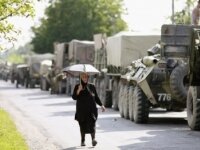New BTR Vehicles in Occupied Apkhazeti
25 April, 2013
 In summer of 2013, 7th Russian military base in the occupied Apkhazeti will replenish its araments in the form of upgraded armored vehicles. Specifically, Russian Defence Ministry is set to deliver 40 armored vehicles of BTR-82à type to the said base on the occupied territories to replace BTR-80 type vehicles with much weaker fire power.
In summer of 2013, 7th Russian military base in the occupied Apkhazeti will replenish its araments in the form of upgraded armored vehicles. Specifically, Russian Defence Ministry is set to deliver 40 armored vehicles of BTR-82à type to the said base on the occupied territories to replace BTR-80 type vehicles with much weaker fire power.Russian armed forces which invaded Georgian territories during the August 2008 war, employed BTR-80 type armored vehicles (several of them were destroyed or captured by Georgian militaries).
In 1992, via its 10th motorized rifle division stationed in Akhaltsikhe, Moscow gave several dozen armored vehicles to the Georgian army.
Purchases of new allotments of BTR-80, mainly from Ukraine, started from 2005. These vehicles could be seen on Rustaveli Avenue during military parades.
Before the August war, Russian peace-keepers used to move around the Tskhinvali region on their old BTR-70 armored vehicles just like in Apkhazeti but also before the war they already had embarked on gradual replacement of the old type vehicles with BTR-80 armored vehicles. Around this time, the Defence Ministry purchased upgraded BTR-70 type armored vehicles from Ukraine, which had their engines and carburetors replaced with diesel motors.
During the August war, neither Russian nor Georgian armored vehicles had played a decisive role in military operations. Nevertheless, BTR-80 type armored vehicles accounted for the considerably enhanced mobility of tactical groups of Russia’s leading battalions. What is more, a portion of Russia’s BTR-80 vehicles had anti-cumulative iron bars installed on them, while others even featured special radio-electronic devices to muffle radio waves used for the activation of remotely controlled explosive devices.
After the August war, both Russian military bases in the occupied territories have had to do with BTR-80 vehicles till now. A part of it in the 7th Gudauta occupation base will be replaced with 40 BTR-82a type armored vehicles in one month.
Capabilities of BTR-82a type armored vehicles are much higher than those of BTR-80. It boasts 300hp enforced diesel motor, improved transmission and suspension system and hence increased average speed and off-road performance. The most important change however happened to the enforcement of the armament.
In contrast to BTR-80, BTR-82a has an external fighting module remotely guided from inside the car. This novelty solved the problem of poisonous gases arising during machine gun operation (especially during protracted spurts) and spreading inside the vehicle due to insufficient ventilation.
The remotely guided module contains 30mm caliber automatic cannon (which is installed on BMP-3 infantry military vehicles and amphibious military vehicle BMD-4) and 7.62mm caliber machine gun PKTM.
Addition of the 30mm automatic cannon to BTR turns the latter into a quasi-infantry military vehicle because missiles shot from this cannons would travel at the speed of 1120m/sec and pierce armor of any military vehicle. Creators of this cannon claim that if the cannon operator manages to fire eight missiles into almost a single spot on the tank’s 120mm thick armor than they could penetrate it for all practical purposes.
The 30mm automatic cannot mounted on BTR-82a vehicles is effective against troops within the 4km range, against lightly armored cars within the 2km range and against helicopters within the 1.5 km range.
One should also consider the fact that the BTR-82a fighting module is stabilized in two planes, has the capacity to search and identify targets both in day and night times, and integrates modern electronic equipment of fire management. These all enhances efficiency of work by a BTR-82a crew to hit targets while on the move even at night.
No less importantly, Kevlar plates affixed to the internal surface of the armor doubles the security of a BTR-82a crew and landing troops carried inside, especially against explosion debris. The floor cover contains special rubber blankets to soften the severity of impact wave from exploding enemy ordinance.
The front and sides of the BTR-80 armor are 10mm and 7-9mm thick respectively, while that of turret measures 7mm. Sadly, these figures are likely to remain same for BTR-82a. It is thus very much plausible that the armor of BTR-82a would not withstand fire from a high caliber machine gun. Moreover, the side armors of BTR-82a would not stand a chance in the face of close range (30-50m) fire from armor penetrating 7.62mm bullets too.
Of course, the modernized Russian armored vehicle BTR-82a does not represent a wonder weapon and its elimination or knock-out should not be an insurmountable task (especially, with a grenade launcher). Yet, anyone who happens to counter it should be acutely aware of power and precision of fire from its 33mm stabilized automatic cannon.





















































